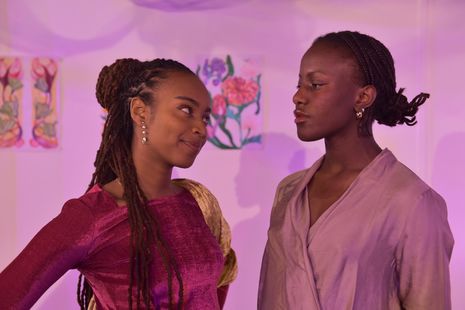Beneath the Flower is a play of tricky nuances
This classical reimagining, while tonally uncertain at times, is still a stylish repicturing of the conflict between Carthage and Rome

Adapting classical stories for the stage can be a gamble. After all, the original writing, whether in the form of poetry or drama, translated or not, often carries a tone of sombreness that’s only to be expected from a narrative that originated thousands of years in the past, whereas student performances are expected to be colourful, vivacious, and youthful. With the right interpretative flourishes, however, such adaptations can deliver satisfying results, as in this stylish repicturing of the conflict between Carthage and Rome.
Writer Senan McSweeney-Davis evokes for us the tale of Sophonisba (Fareedah Ibrahim-Garb a), who eventually consumes poison rather than be held up as a malicious token of Roman triumph, having been pushed back and forth between two suitors (Syphax, played by Hugo Aaronson, and Massinissa, played by Rosie Nicol). Right from the start, this production is visually arresting; swathes of sheeny fabric are hung up alongside floral paintings, and an eerie pink light suffuses the Corpus Playroom’s L-shape, alternately plunging into bursts of blue and purple at moments of heightened emotion (all due credit to lighting designer Tianhao Wang). The costuming too is striking, though it contains a few anachronisms – central figures like Sophonisba and Elissa wear what are clearly intended to be period-specific garments, while the servant girl’s attire wouldn’t be out of place at a contemporary party.
“Right from the start, this production is visually arresting”
The performances shine through here, elevating even the occasional moment of flatness or overly direct exposition in the mostly engaging script. Moments of comedy, like Syphax attempting to quietly enter a room with caricatured fastidiousness, or the blatantly heinous ‘doctor’ preparing to assassinate Massinissa with moustache-twirling relish, send the audience into genuine peals of laughter. If anything, the production’s main flaw (and it is an innocuous one) is its own uncertainty regarding tone. At certain points, for example, when Scipio (Sophia O’Callaghan) taunts Sophonisba’s handmaid Anna (Zeynah Yusuf) with her own subservience, and teeters on a thin line between cruelty and sexual predation, the play seems like a grave meditation on the casualties of war and the use of women like pawns on the chessboard of male conflicts. At other points, as when the poisoning plot against Massinissa is foiled, the play strays definitively towards the farcical (The Princess Bride’s ‘INCONCEIVABLE!’ scene comes to mind). This is not to say that the production cannot aim for dark comedy, but that it needs to do so with a little more conviction so as not to seem tonally discordant.
“This is not to say that the production cannot aim for dark comedy, but that it needs to do so with a little more conviction”
I particularly enjoyed the gender-bending element of the casting; having young women inhabit the roles of slouching, slovenly men embodying the phallocentrism of war is both challenging for the actors and amusing for the audience. Occasionally, the performances come across as somewhat tentative and over-controlled, as though the actors are afraid to completely let go and lean into the passion. I believe this is the result of a generalised issue with student theatre, not with any performer in particular – an issue that professional actors are lucky enough not to be afflicted by. The knowledge that one’s friends and acquaintances are almost certainly in the audience creates an unavoidable self-consciousness; it’s difficult, in that state, to give oneself over unreservedly to the primal noises of grief and heartbreak. Given these circumstances, the cast does remarkably well at conveying these tricky nuances; Sophonisba’s last speech, a soliloquy about the impossibility of choosing to live without dignity, delivered by Fareedah Ibrahim-Garba, is a special highlight.
Part of me wishes that the writing had leaned more into the comedic side of proceedings. The moments of Beneath the Flower that stay with me most distinctly are those in which the characters come across as almost kings and queens of Camp, dispensing with realism for the sake of stylised physical humour and deliberate exaggeration. This is not to say, however, that the graver subject matter grappled with here is somehow devalued. Student writers often feel compelled to nominate something ‘important’ or historically rich as their subject matter; while I applaud their discernment, and am certainly in favour of intellectually rooted dramatic pieces, I feel that this particular script could have perhaps been more effective had it been split in two. One production could have been the ostentatious Vaudevillian comedy that we catch glimpses of when the doctor/murderer first limps in; the other could have been the socially attuned rendering of war’s impact on women in the ancient world that had the audience catching their breath.
 News / Caius mourns its tree-mendous loss23 December 2025
News / Caius mourns its tree-mendous loss23 December 2025 News / Clare Hall spent over £500k opposing busway 24 December 2025
News / Clare Hall spent over £500k opposing busway 24 December 2025 Comment / Yes, I’m brown – but I have more important things to say22 December 2025
Comment / Yes, I’m brown – but I have more important things to say22 December 2025 Comment / The ‘class’ of Cambridge24 December 2025
Comment / The ‘class’ of Cambridge24 December 2025 Interviews / Politics, your own way: Tilly Middlehurst on speaking out21 December 2025
Interviews / Politics, your own way: Tilly Middlehurst on speaking out21 December 2025








